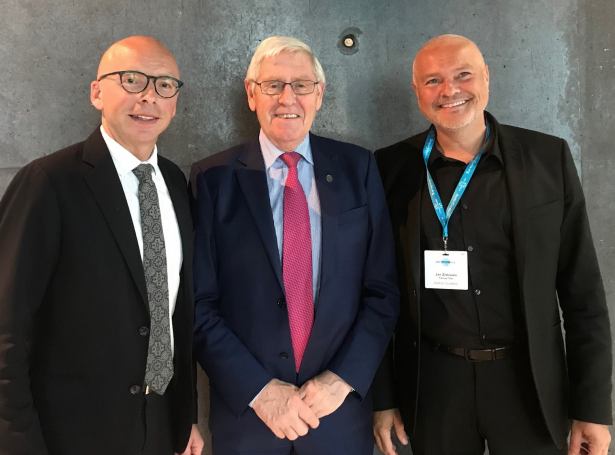
Tað er ikki hvønn dag, at Føroyar seta seg á ovastu rók á einum so týðandi altjóða palli, sum Arctic Circle ráðstevnan er. Hon verður hildin í Reykjavík í hesum døgum við luttøku av fleiri av heimsins londum. Endamálið við henni er at varpa ljós á arktiska økið við tess stóru møguleikum og avbjóðingum og ikki minst við tess íbúgvum, sum umsita henda gimsteinin á og rundan um Norðpólin.
Sunnudagin áttu fleiri av føroysku luttakarunum við landsstýrismanninum í uttanríkis- og vinnumálum á odda ein av serstøku pallunum í listarliga sjáldsama bygninginum Hørpuni í Reykjavík. Undir heitinum “The Faroe Islands as a Model Arctic Hub", Føroyar sum eitt modell fyri ein arktiskan hub, legði Poul Michelsen, landsstýrismaður fyri, og eftir hann komu so føroysku vinnulívsmenninir Rúni M. Hansen, nevndarformaður í Bakkafrost og Jan Ziskasen, stjóri í Føroya Tele.
Teir tríggir høvdu framløgur um Føroyar sum eitt framkomið land. Jan Ziskasen hevði eina sera áhugaverda framløgu um Føroya Tele og hvussu framkomin vit eru innan telesamskifti. Rúni M. Hansen hevði eina eins spennandi framløgu um aling og Bakkafrost og um, hvussu frammaliga Føroyar eru innan aling – í veruleikanum millum heimsins bestu innan laksaaling. Tvs. tvey málsøki hjá landsstýrismanninum. Sum skilst var stórur áhugi kring hesar báðar framløgurnar eins og henni hjá landsstýrismanninum sjálvum.
Undir heitinum “Transforming the Faroes – digitalization and green power”, legði Poul Michelsen, landsstýrismaður í uttanríkis- og vinnumálum fyri. Hann segði m.a.:
Dear guests
I would like to thank the Arctic Circle for arranging this session called “The Faroe Islands as a Model Arctic Hub". I am happy to get the opportunity to give you a little insight into the Faroese society.
- The Faroese are pioneers by nature. The people who settled the Faroes were pioneers. Our fishermen have always been pioneers both when it comes to discover new fishing areas and to using new technology.
As pioneers, our thinking is often bold, but that has also taught us the skills to reflect and learn from past mistakes in order to move forward.
- The pioneering spirit has been the back-bone of what is today the world’s leading salmon farming industry and one of the leading fishing nations in the world.
- I am very pleased to be joined by CEO of Faroese Telecomm Jan Ziskasen and Chairman of Bakkafrost’s Board of Directors Rúni M. Hansen. They represent two of our finest and most internationally competitive companies in the Faroes.
- A strong work ethic and international outlook and logistical connectivity to our markets is part of what makes the Faroe Islands a model Arctic Hub today.
- But what is more important is that we have a long tradition to develop our own infrastructure in the Faroes.
First with roads, ferries and tunnels – and later bridges and subsea tunnels.
A well connected nation is the back-bone of a dynamic and adaptable society. It allows for a mobile workforce and equal regional development.
- The physical infrastructure within the Faroes is only haft the story. The other half is the digital infrastructure – telephone and later internet connection across the entire Faroe Islands, which are vital to the welfare of our citizens and our economy.
- Over the last few years, we have experienced economic growth, a record high population, aquaculture makes up more than half of the total value of exported goods – a stark transformation over a short period of time.
- Strick regulatory framework based on high veterinary standards in the aquaculture industry
- New legislation with increased environmental requirements in order to ensure sustainability over time
- In order to be an Arctic Hub, the first thing we need is a strong economy. Our economy is based on fisheries and aquaculture and related service industries.
It is therefore vulnerable and we are continuously working to strengthen the foundation of our economy, part of which is diversification of markets and part of which is diversifying by creating new platforms and business sectors.
- As we are moving into the new digital era, we continue to be frontrunners by creating smart solutions.
- Smart solutions are often both responsible and green.
I am going to present two national initiatives which we are important steps in securing a future for our country by building a modern and attractive society.
First I will give a brief overview of the National Digitalisation Initiative and then I will – also in short - present the 2030 Transformation to Green Power.
The National Digitalisation Initiative entered the political agenda in 2014 and is seen as a brick in the continued making of the modern Faroes .
The main object is to create a national digital platform the Faroe Islands over a period of four years from 2016 to 2020. The primary reasons for taking this decision were the challenges which faced our society.
The government wanted the digitalisation initiative to:
- Give citizens and businesses an opportunity to get access to e-public services from all service providers.
- Create opportunities for new and modern digital services
- Create new industries and business sectors.
- Attract highly skilled people to the Faroes
- Make public and private administration more efficient.
- Improve trust between citizens and administration and strengthen democracy
The conditions were in place for starting the digitalisation project:
- The back-end IT infrastructure is in place and as we will hear from Jan Ziskasen in a moment – we have a highly developed digital infrastructure network, 4G coverage in all populated areas and 5G is scheduled to be launched in 2020.
- All vital government institutions have a highly developed IT-infrastructure. For instance - we have a nationwide healthcare system, a nationwide tax collection system, used by national and municipality institutions as well as by private firms.
And we have a nationwide Information Management System used by all national and municipality institutions, which gives a day-to-day overview over the entire public sectors’ expenditures.
With these existing conditions, it is possible for the National Digitalisation initiative to create a platform on which to both provide and process all services digitallu. The elements of the Digital platform are:
- An Electronic identity (e-id)
- A Citizen Portal
- Basic Data
- Data Exchange Layer (Heldin)
With a national citizen portal it will be possible to put all public services, and services from major private stakeholders, like banks and insurance companies, on one single portal.
The National Digitalisation Initiative will only create some of the central services, while service providers will fill in the gaps in order to make the system functioning and a practical benefit for everyone.
By making the platform and the data easily and freely accessible it will be easier for service-providers - both public and private – to move relevant data and services to the citizens and to the private sector.
New business opportunities will arise, and it will be easier for citizens and private companies to access data and to execute their own affairs digitally.
Politically, there has been broad consensus regarding the digitalisation initiative since its beginning. The budget for the digitalisation projects is 150 mio DKK, where the Government´s part of the funding is 60% and major stakeholders’ part (banks, insurance companies, power companies) is 28% and the municipalities’ part is 12%.
We have been inspired by the frontrunners in e-governments, among others Estonia. Now it seems that other countries are looking to us. Greenland has shown interest in learning from the Faroese experience and these days we have representatives from the National Digitalisation Initiative in Dubai, participating in an international jury to evaluate the public digitalisation Initiatives in the Emirate state.
Then I would like to briefly touch upon the change to green energy
One of the main objects of this government has been to speed up the shift to green energy.
The aim is, that in 2030 all energy consumption on land shall come from renewable sources and in 2025 at least half of the houses shall be heated with renewable energy.
As we all know it is easy to set goals, but much more difficult to reach them.
But over the last ten years a lot of progress has been made:
- Production from wind has increased from 4 to 18 MW.
- Some 2000 households out of 18000 are now heated with geothermal or electirc heat pumps or heating derived from
left-over energy .
- Only this year the fleet of electric cars has grown from 10 to 100.
This is due to various policy initiatives:
- Heat pumps are exempt from paying VAT.
- Electric cars are exempt from registration fees, VAT and roadtax.
- There is a bill in parliament proposing differentiation in electricity prices opening up for the possibility of introducing cheaper energy prices for heatpumps and electric cars.
If the parliament approves the bill, which I expect it will, it will speed up the green transition.
On the electricity production site a lot af new development happens right now:
- We have two tenders on windenergy 12 MW + 18 MW to be finished by 2020.
- This means we by then go from 18 to 48 MW in windenergy.
- We are also planning two wind/hydro pumped storage plants. The smaller one shall be finished in 2021 and the larger one in steps from 2024 to 2030.
Over the past years an extensive analysis has been conducted on how to combine renewable energysources in order to reach the goal to be 100% green in 2030.
The result is a roadmap with solutions, which are both economically and technically feasible. They include wind, sun, pumped hydro storage, batteries, smart grid solutions and perhaps tidal energy on the production site, and heatpumps and electric cars on the consumer site.
-------------------
The idea behind outlining the examples of the National Digitalisation Initiative and the 2030 Green Transformation is to show how a traditionally one-legged economy is finding innovative ways to continue developing.
On a map, we may seem both isolated and distant. But our international, national and digital infrastructure make us dynamic and adaptable.
Paired with economic growth, a skilled and educated workforce and a rich cultural tradition it is what makes us an Arctic Hub.
Ladies and gentlemen – thank you for your attention.

Á arktisku ráðstevnuni í Reykjavík hitti Poul Michelsen, landsstýrismaður m.a. Fiona Hyslop, sum er skotskur uttanlandsráðharri. Hon er eisini "cabinet secretary" fyri mentan og ferðavinnu. Tey umrøddu framtíðar samstarv millum Skotland og Føroyar.

Vinarliga broyt tínar kennifíla - og privatlívsstillingar fyri at síggja hetta innihald